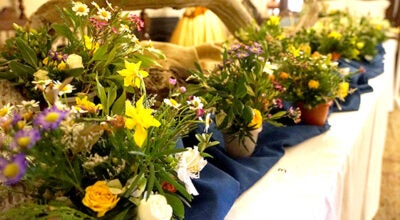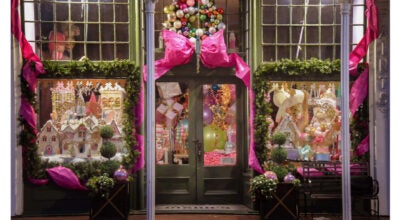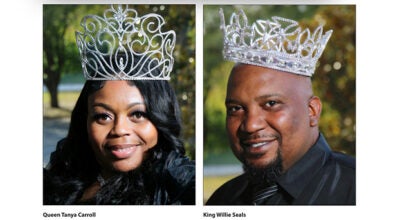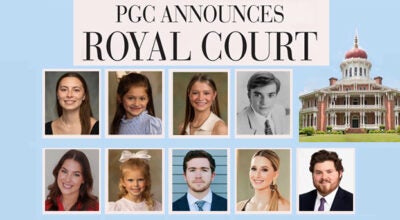Walking tour of historic churches part of conference
Published 12:03 am Wednesday, February 19, 2014

HISTORIC NATCHEZ FOUNDATION PHOTO —
A historic photo documents an address in the Zion Chapel African Methodist Episcopal Church sanctuary by Mississippi field secretary of the NAACP, Medgar Evers.
When the defining sound of the Civil Rights era was the gospel song “We Shall Overcome,” it’s no surprise churches played a pivotal role in the organizing of the freedom movement.
Sunday — the last day of the Natchez Literary and Cinema Celebration — the NLCC will have a free walking tour of some of the churches that played a role in the local Civil Rights movement.
The tour will start at 1:30 p.m. in the parking lot of Zion Chapel African Methodist Episcopal Church, will walk to Rose Hill Missionary Baptist Church and then loop back downtown, making stops at Beulah Baptist Church, Zion Chapel A.M.E. and Holy Family Catholic Church.
The tour will also pass by St. John United Methodist Church, though the church will not be open.
“This year’s theme for NLCC is the Civil Rights movement and the voices of the Civil Rights movement,” NLCC Co-chairman Carolyn Vance Smith said. “Voices fits in the churches perfectly because they were gathering places for people who had all of a sudden been given the right to vote, and they needed to gather and discuss this new freedom and how to act on it.”
Each church on the tour will have a history discussion for approximately 45 minutes, which will be followed by a 15-minute interval for walkers — or those who want to drive themselves — to arrive at the next church, Smith said. The tour is expected to end at 5:30 p.m.
“It is always a pleasure to be invited to somebody’s church, and the older members of the congregations are so excited about sharing the stories of the movement because they were there and their parents were there,” she said. “It brings the movement into focus in yet another way.”
Natchez National Historical Park Service Director Kathleen Jenkins said NPS tour guides will lead the walk between the churches, but won’t be leading the discussions at the presentations.
“I am excited about the format because it is a grassroots tour, and each of these churches is telling its own story,” she said. “This is not something the park service has put together.
“The goal is to connect people to the tangible resources of this church and this neighborhood with the intangible ideas of what was going on during the Civil Rights era and what was happening when brave people were standing up and trying to create a more perfect union.”
The tour, titled “Sermons, Songs and Solutions,” is free.
At the end of the tour, participants will receive a free postcard print of original art by Carolyn Gwin that depicts the five historic African American churches on the tour.
History of churches on tour:
(Written by Mimi Miller)
Zion Chapel African Methodist Episcopal Church
Zion Chapel A.M.E. Church was built as the Second Presbyterian Church.
Unable to support two churches, First Presbyterian Church sold the building in 1868 for $7,000 to Zion Chapel A.M.E. Church and financed the sale.
The fledgling church’s pastor was Hiram R. Revels, who was born free in North Carolina and came to Mississippi to minister to newly freed African Americans. In 1869, Revels became a state senator and was subsequently appointed by the Mississippi Senate to serve the remainder of Jefferson Davis’s term in the U.S. Senate. He was the first African American to sit in either house of the U.S. Congress. Revels declined to stand for re-election and became the first president of Alcorn State University.
By 1874, Zion Chapel’s enterprising young congregation had paid off the church mortgage. In the late 19th century, the church built its existing parsonage at 15 St. Catherine St. and initiated a school known as Ward Academy that had 170 students enrolled in 1890.
In the early 20th century, Zion Chapel built a mission church, Zion A.M.E. Church No. 2 that was often referred to as Little Zion and still stands at 7 Quitman St.
In 1902, the Cylopedia of African Methodism in Mississippi described Zion Chapel A.M.E. Church as the “largest, most intelligent, wealthiest and most influential church in the Mississippi Conference.”
In the 1960s, the church played a vital role in the Civil Rights movement by housing meetings of the National Association for the Advancement of Colored People. A historic photograph documents an address in the church sanctuary by Medgar Evers, then Mississippi Field Secretary of the NAACP.
Rose Hill Baptist Church
Rose Hill Baptist Church is the third church building occupied by the congregation. The first building dated to circa 1854 and was replaced in 1893 with a grander wood structure with a 60-foot bell tower. The 1908 explosion of the Natchez Drug Company caused the fire that destroyed the second building. The Rose Hill Baptist congregation rebuilt on the same site but a grander and much substantial brick church in the late Victorian Gothic Revival style. In 1912, the congregation installed a Moller organ, which is listed with the Organ Historical Society.
Although today’s church building dates to the early 20th century, the congregation has its roots in the antebellum period. Rose Hill Baptist is the oldest black Baptist congregation in Mississippi and traces its origins to 1837 in a shared ancestry with First Baptist Church. Both churches evolved from the Wall Street Baptist Church
An 1858 deed filed in the courthouse documents the 1854 organization of a distinct antebellum congregation and the construction of a building for African American Baptists in Natchez.
The name Rose Hill probably derives from the 12-acre Rose Hill estate in the old northern suburbs of the city that was owned by Rose and Emma Marcilly, nieces of Catholic bishop, John Chance. The Union Army demolished the Rose Hill house in constructing Fort McPherson.
At the end of the Civil War, a remarkable former slave, Randall Pollard, became the minister at Rose Hill Baptist Church and served for many years. He died in 1894 at the age of 90. The Mississippi Legislature incorporated Rose Hill Missionary Baptist Church on Aug. 8, 1870, marking its formal separation from the Wall Street Baptist Church.
Members of Rose Hill, like many other African American churches in Natchez, participated in the Civil Rights movement and Rose Hill pastor Dr. Jonathan Rucker was a leader in the effort. Rucker also pastored St. Marks Baptist on Kingston Road.
Holy Family Church
Holy Family Church is the oldest African-American Catholic Church in Mississippi. Established by the Diocese of Mississippi, Holy Family later became, in 1899, a mission church of the order of St. Joseph of the Sacred Heart, better known as the Josephites, a religious order of priests and brothers committed to serving the African American community.
At the end of the Civil War, the Catholic African American population initially worshipped at St. Mary Basilica, where Bishop William Henry Elder opened the first Natchez school for African American children in 1866.
However, African American Catholics objected to being relegated to the balcony or a back corner of the church and began to demand full participation in parish life. The church responded by establishing Holy Family Parish in 1890.
The first building and school were located on Beaumont Street but the rapid growth of the parish resulted in the 1894 construction of the grand Victorian Gothic Revival church on St. Catherine Street.
For more than a century, Holy Family Church has played an integral role in the religious, educational, cultural and social life of African-Americans in Natchez. Church members have been excellent stewards of their architectural landmark, reflected in the preservation of an important historic organ, original pews, gas light reflectors and turn-of-the century electric lighting.
The Josephite order has a strong commitment to social justice and that commitment coupled with the activism of church members placed Holy Family in the forefront of the Civil Rights movement. Father Amos Gaudette, S.S.J., organized the first concerted drive for voting rights. The first petition to integrate the Natchez public schools was written and signed in the church parish hall in 1955.
In the 1960s, Holy family priest Father William Morrissey, S.S.J., dedicated most of his time to the Civil Rights movement and became the first white person to hold office in the Mississippi state chapter of the NAACP.
He also ran for the state legislature on the ticket of the Mississippi Freedom Democratic Party. The parish hall became a meeting place for the NAACP which operated an office across St. Catherine Street in the John Banks House. Holy Family’s important role during the Mississippi Movement was recognized in 2012 when the Mississippi Department of Archives and History awarded the church a special restoration grant related to its Civil Rights history.
Beulah Baptist Church
Beulah Baptist Church was organized on Dec. 30, 1896, by a group who split from the Rose Hill Baptist Church. The Rev. S.D. Young, who became the first pastor, suggested the name of Beulah Missionary Baptist Church. The first church building was erected in 1901 on B Street but was destroyed by fire on March 6, 1911.
The fire destroyed the church building but not the church spirit, and, in 1912, the congregation built a new church on the site of the 1901 church. The congregation has now worshiped in the “new” church building for more than a century. Improvements have been made to the church building over time. In the 1950s, the church added an annex, installed restrooms and gas heaters, and acquired a piano.
The church also participated in Spring Pilgrimage in the 1950s by hosting performances of Highway to Heaven by the Natchez City Chorus. In the 1960s, the church purchased an organ, brick-veneered the exterior of the building and installed heating and cooling.
The longest serving pastor was the Rev. Walter Logan who was elected to the pastorate in 1961 and served until his death in 2001.
He led Beulah through the tumultuous years of the Civil Rights movement and into the dawn of the 21st century.
In the 1970s, Beulah purchased a bus, which contributed to the growth of the church and the Sunday school. The bus provided transportation for many loads of children and adults to worship at the church.
Beulah has always had a vision for a fuller and more expansive church and has increased its landscape by acquiring additional property on B, North Rankin, and Martin Luther King Jr. streets. The check interior was renovated along with the addition of a balcony in time for the celebration of its 100-year anniversary in 1996.
Beulah has striven throughout its history to be a trailblazer in the community and has opened its doors for many community events, including club meetings and civic events. During the Civil Rights movement, Beulah was a “beacon of light and hope” and hosted numerous meetings of the NAACP. Portions of the movie “Black Natchez,” which portrays the early days of the movement, were filmed in Beulah’s large sanctuary.
St. John United Methodist Church
St. John United Methodist Church was built between 1886 and 1892 and is an example of vernacular Victorian Gothic Revival architecture. It first housed the congregation of the First Baptist Church, an offshoot of the Wall Street Baptist Church.
By 1910, insurance maps identified the building as home to St. John Methodist Episcopal Church, but the church probably did not acquire the building until 1915, when a new cornerstone was installed that identified St. John Methodist Church as the owner.
St. John has always had a small congregation and has become largely inactive over the past few years.





